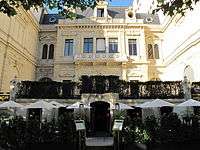Hôtel de la Païva
Coordinates: 48°52′9.34″N 2°18′27.29″E / 48.8692611°N 2.3075806°E


The Hôtel de la Païva ("Mansion of La Païva")[1] was built between 1856 and 1866[2] at 25 Avenue des Champs-Élysées by the courtesan Esther Lachmann, better known as La Païva. She was born in modest circumstances in the Moscow ghetto, to Polish parents. By successive marriages, she became a Portuguese marchioness and a Prussian countess, this last marriage supplying the funds for the hôtel, at which she gave fabulous feasts.
History
La Païva had already acquired a luxurious mansion at 28 Place Saint-Georges in Paris, but dreamt of building another on the Champs-Élysées, which she thought the most beautiful avenue in the world. According to legend, in her youth she had been pushed out of a cab by a hurried customer and slightly injured. She promised to herself to build herself a house on the avenue where she fell. After her marriage to Albino Francisco de Araújo de Paiva, the self-styled [3]Portuguese marquis de la Païva, she had the funds to do so.[4]
Once the hôtel was built, she received many notable people there, including the Goncourt brothers, Théophile Gautier, Léon Gambetta, Ernest Renan, and Hippolyte Taine. In 1877, suspected of espionage, La Païva and her husband, Prussian multimillionaire Count Guido Henckel von Donnersmarck, whom she had married in 1871, left France and withdrew to Silesia, where she died in 1884.
Since 1903, the Hôtel de la Païva, with its large yellow onyx staircase, Moorish-style bathroom, sculptures, paintings, and a ceiling by Paul Baudry, has been home to the Travelers Club.
The double entrance to the courtyard of the hôtel has been preserved: one door was for entry of cabs and the second for their exit, avoiding the need to turn around. The courtyard has been replaced by commercial establishments: first a financial exchange office, and later a restaurant.
The building and its furnishings
La Païva commissioned architect Pierre Manguin[2] to build the hôtel in Italian Renaissance style. He worked with the sculptors Léon Cugnot, Eugène Delaplanche, Eugène Legrain, Ernest Carrier-Belleuse and Jules Dalou.[5]
The hôtel is especially famous for its beautiful yellow onyx staircase, probably unique in the world. The stairs inspired the contemporary witticism by the playwright François Ponsard, adapted from Phèdre, "Ainsi que la vertu, le vice a ses degrés" ("Like virtue, vice has its degrees"; in French, the final word, degrés, means both steps in a staircase and levels of a hierarchy.) [6][7]
The bath
The Napoleon III style bathtub was sculpted by Donnadieu from a block of yellow onyx (1.85 m - 900 kg). This material, called onyx-marble, was found in a Roman quarry rediscovered in 1849 near Oran (Algeria) by Delmonte. This type of onyx was used at the time of Napoleon III for the decoration of only the most prestigious buildings. At the Universal Exhibition of 1867, Donnadieu received a distinction for "onyx marbles designed with the elegance which is the supreme attribute of Parisian workers" (from "Algeria to the Universal Exhibition in Paris, 1867" O . McCarthy). La Paîva is said to have taken baths of milk, lime-blossom, and even champagne.[8]
Another tub in silver was equipped with three taps, the third being used for milk or champagne.[9]
Anecdote
During construction of the hôtel, Augustin Scholl remarked to those who asked about the progress of the work, "The construction is well underway: just ask the sidewalk." [10]
Notes
- ↑ The French word hôtel is in this case short for hôtel particulier, or private mansion, rather than indicating a business offering public rooming accommodations.
- 1 2 "Console du grand salon de l'hôtel de Païva". Retrieved 4 July 2013.
- ↑ Celsa Pinto, Trade and Finance in Portuguese India (Concept Publishing Company, 1994), page 78 Amar Farooqui, Smuggling as Subversion: Colonialism, Indian Merchants, and the Politics of Opium, 1790-1843 (Lexington Books, 1998), page 238 Agnès Pellerin, Les Portugais à Paris: au fil des siècles & des arrondissements (Editions Chandeigne, 2009), pages 111-113 Virginia Rounding, Grandes Horizontales (Bloomsbury, 2003)
- ↑ Allen, Peter (28 March 2010). "French 'Love palace' built by famous prostitute restored". The Daily Telegraph. London. Retrieved 4 July 2013.
- ↑ Musée d'Orsay website
- ↑ http://demarchesenescaliers.blogspot.com/2009/03/stair-hotel-de-la-paiva.html
- ↑ Horne, Alistair. The Fall of Paris. (Penguin: New York, 1990)
- ↑ http://cyberscriptus.ifrance.com/cyber21/paiva.html
- ↑ http://www.oomark.com/destins/_destins_paiva_._situee_dans_l_hotel_de_la_paiva_avenue_des_champs-elysees_a_paris_cette_baignoires_comporte_trois_robinets._pourquoi_.html
- ↑ http://www.canalacademie.com/Banlieue-et-logement.html